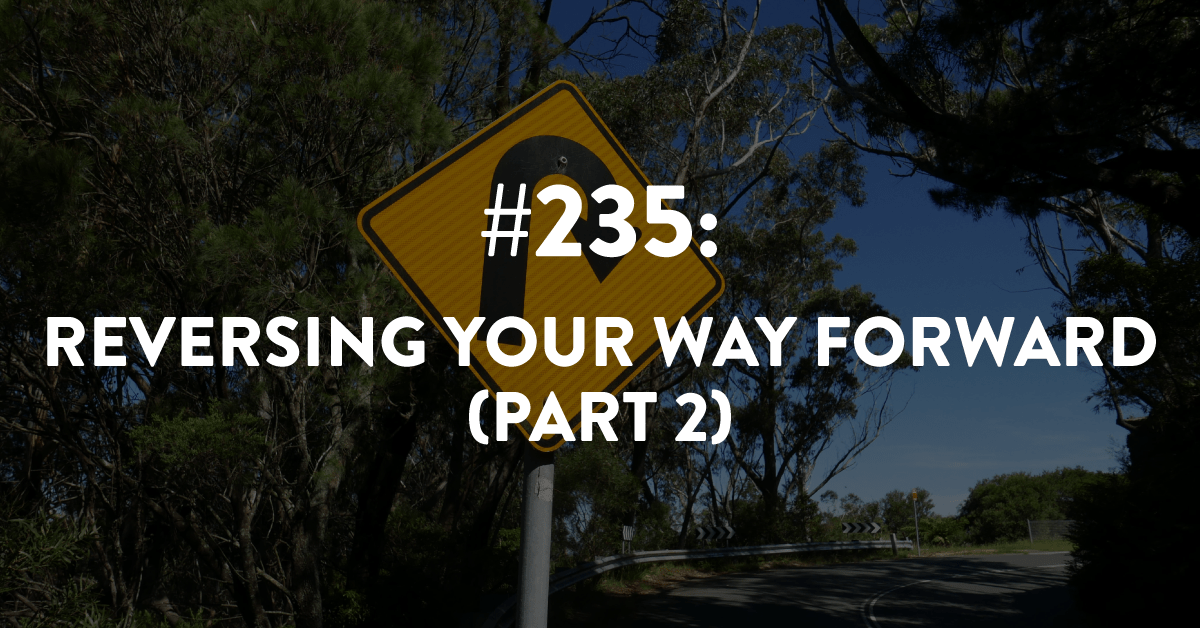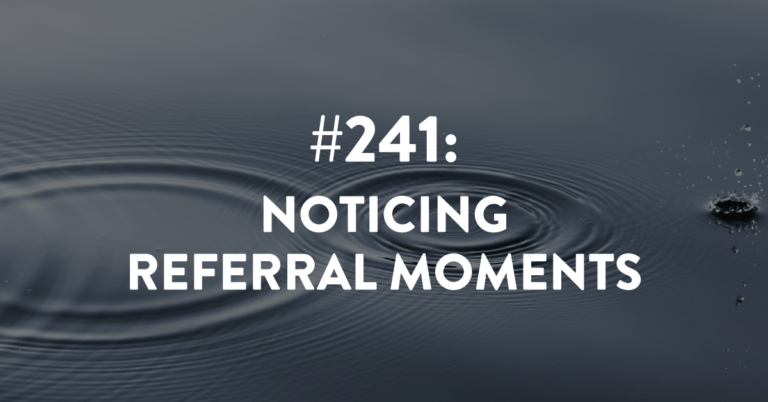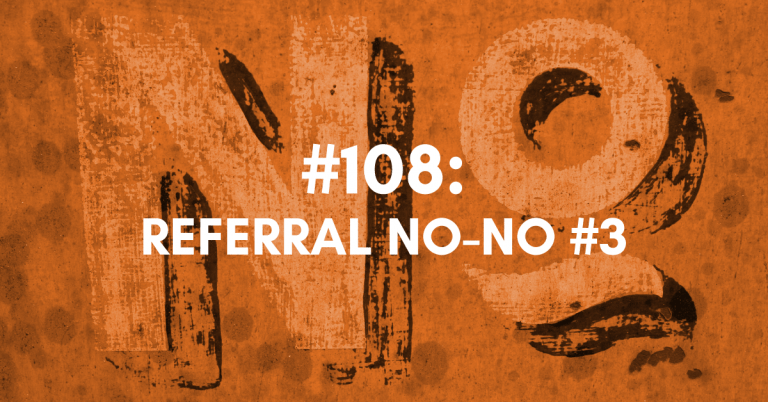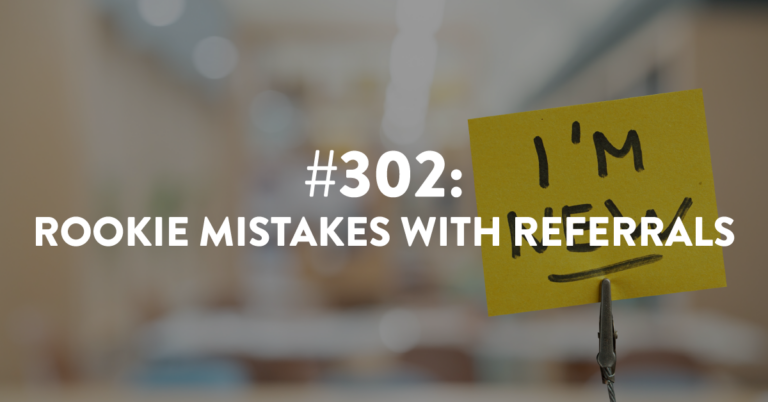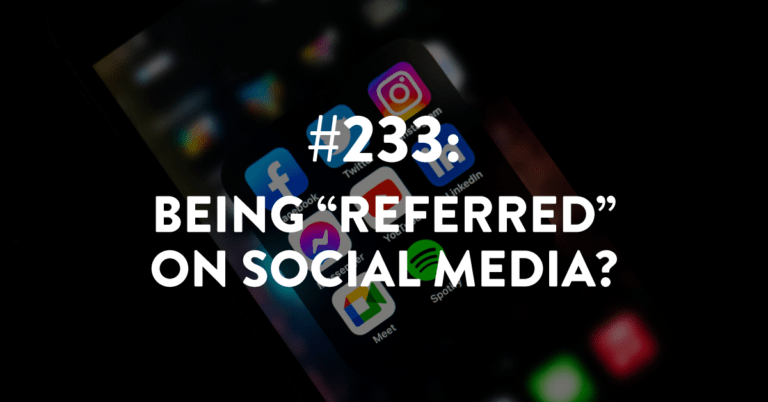Ep #235: Reversing Your Way Forward (Part 2)
It’s time to wrap up our two-part series on reversing your way forward. Last week we talked about reflecting, and this episode is all about how we reverse our goals so that we can crush them. You’ll learn about a key thing people miss when setting goals and a process I created to help plan out your goals with the big picture in mind and a way to accomplish them.
There can be so much overwhelm that comes with planning, but it’s still important to check in with your big-picture goals and create a plan that is rooted in what you ultimately accomplish. So listen in and get ready to take notes!
Links Mentioned During the Episode:
Want to work with me to finally take control of your referrals? Check out the three ways I work with clients on our Home Page. I offer self-study online programs, a group coaching program and a 1:1 VIP Referrals in a Day experience.
Reverse Goal Setting Series on the podcast last year: Start with Episode #181 and end with Episode #185.
What’s Coming Up:
2023 is fast approaching my friends. If you know taking control of your referrals – for real – is on the to do list… then start considering now how you want to learn from me. Is an online, self-study program just the ticket to learn one of my foundational strategies? Or a group coaching format where we build out your 90 Day Sprints and stack your referral strategies for success – while you can go at your pace and in a group community. Or maybe you want to work with me 1-on-1 as a VIP where I build for you (and your team if you have one) your referral strategy – complete with all processes, language and templates. We’ll knock it all out in one day and we’ll meet in person. The VIP option is the speed option. Check out all our programs and services on our home page at staceybrownrandall.com or shoot me an email if you have a specific question. Joining now gives you time to be build so you are ready to start 2023 referral strong!
Looking for Referral Resources:
Take the Referral Ninja Quiz to test your skills and abilities at generating referrals. (FREE)
Buy my book – Generating Business Referrals Without Asking – and learn how to generate referrals through my 5 steps. (LESS THAN $16)
Check out our free resources on our Freebie Page. We have broken the free resources into two sections, based on if you’re less than 2 years in business or more than 2 years in business. Enjoy!
Consider joining Building a Referable Business™ – a unique way to learn all of my referral strategies and tactics with ongoing weekly access to me to answer your questions and help hold you accountable! Check it out and submit your application today!
Next Episode:
Next episode is #236, and I’ll share my year-end referral reflection.
Download The Full Episode Transcript
Read the Transcript Below:
Stacey Brown Randall: It’s time to wrap up this two-part series on Reversing Your Way Forward. We reflected in our last episode and this episode, we’re going to be tackling how we reverse our goals so we can crush them.
Hey there, and welcome to episode 235 of the Roadmap To Grow Your Business podcast, a show about helping you build a referable business. I’m your host, Stacey Brown Randall.
Quick recap on the previous episode. We did the reflection step. We reflected on our business and our goals from 2022. Effectively, we reflected on how we did in this past or this year. It’s really important that we reflect back on what happened before we start looking forward.
And then, of course, as part of last week’s episode (that’s episode 234), we also held space to allow ourselves to consider dream ponder, what we want moving forward. And we also held space for the negative emotions that sometimes come up when we’re thinking about what we want our life to look like based on how it’s been.
So, if you didn’t listen to episode 234, I’m going to strongly encourage you to stop, leave this episode, go listen to episode 234, and then come back and join me for this episode as well. It will make way more sense if you do these two episodes in order.
Okay. Now, that we are done with the reflecting, which we did last week, it’s time we reverse your goals. Now, if you want to catch the process of reversing your goals, the reverse goal setting process that I teach, you can go back and listen to episode 181 through 185. That’s me walking you through step by step, the reverse goal setting process last year. So, at the end of 2021, as we were preparing for 2022.
This year, it’s different. Instead of giving you four or five episodes, as I break down the reverse goal setting process, I’m actually doing it different this year, and I’m streamlining a little bit of the process because it is my hope that in streamlining this process, you’ll actually do it because it’s two episodes, and it won’t get lost in the holiday hustle.
Because as we know, there are lots of ways to set goals and prepare for next year’s. We’ve got the systems and the processes and the journals, and the strategies. You’ve got the CEO strategic days and the goal setting days. We know they’re all out there. Retreats, there are a ton of them, and they’re all good. Like doing something, doing any one of those is better than doing none of them, definitely.
But we also know that if we want to be accomplishing what we’re about to write down and say we want to accomplish — if we want to actually accomplish it and if you’re anything like me, well, I prefer a strategy that’s going to hold me accountable based on how it’s created.
Which means it’s got to have a focus on the why. The why do I want these things? And then it actually needs an action plan, so that it’ll make it happen, which means I’ll make it happen in a way that works with how I run my business and my life.
Okay. So, part one was reflecting. If you haven’t listened, go episode 234, then come back and join me here.
This episode is step two or part two, and it’s what I like to call the 5-3-1 plus the action plan. And both are necessary to having a successful year, or should I say years as you go through this process.
Alright. So, let’s start with the 5-3-1. There’s something that people don’t pay attention to when it comes to goals. And that is the why you want it.
When we set goals for just next year, when we say to ourselves, “Hey, I’m going to set goals for just 2023. What do I want to accomplish? What are my goals for 2023?” That’s a very typical statement that a lot of people say this time of year.
But what it doesn’t take into account is the why behind them, because it’s like setting your goals in a vacuum. It’s like looking at your goals with blinders on. And if you’ve ever actually had blinders on or you’ve lost your peripheral vision, you know how disconcerting that can be. You know how weird that can be when you can’t see all around you.
Well, goals are a little bit of the same way. When we say, “I’m just going to figure out what I want to do for next year,” we’re looking at our accomplishments in a vacuum with blinders on. And it doesn’t establish a why do we want that?
Now, if you’ve always wanted to publish a book and you’ve never gotten around to doing it, then it kind of makes sense if you looked at it and said, “Next year I’m going to write my book and try to get it published.” That’s because that’s a goal that’s been following you around that you just haven’t accomplished yet.
So, I’m not saying that there aren’t goals that we just know, hey, maybe next year is the year. Of course, if you say it like that, maybe next year is the year. That’s actually not probably a really good way to stake your claim that it’s going to happen if you start it with maybe. Just as a side note, for those of you who listen to each and every word I say. I don’t want to send anyone down the wrong path.
But the ultimate reason here that we are setting goals is because we want our life to be different. We want our lives to feel different, look different, be different. We want to live a different life.
That may be in a small way or in a big way. And your way are your ways, and we’re not comparing them to anybody else as of what you ultimately want for your life.
But when we just say we’re going to set goals for next year, we’re not paying attention to the why behind it. If you do that goal next year, what does it mean for you five years from now or three years from now, or 10 years from now? What does that mean for you?
So, I created a process called the 5-3-1. We start with setting our five-year vision, which means what do you want to have accomplished in your life at the end of 2027?
We talk about putting these down as bullet points, but really it could also just be a rambling paragraph of what you want your life to look like. And it’s going to be personal and business. You cannot do this and just focus on business. You bring your whole self to everything in life, you need to bring your whole self to your goal setting.
So, when we sit down and we’re like, “Okay, so what do I want to be? What do I want to have accomplished? What do I want to have tackled and crushed? What do I want to be making happen in my life? Where do I want to be at the end of 2027?” That’s five years from now. And that’s where we start with our goals.
Now, here’s the hardest part of figuring out what you want to accomplish in 2027. You ready for it? Okay. The hardest part of figuring out what you want to accomplish by the end of 2027 is when I then tell you, I need you to write down how old you will be at the end of 2027. I know, I said it was painful. Like every time I do this, and I have to write down myself five years older, I’m like, “Give me a break.”
Now, if you know me at all, or if you’re a super long-time listener to this podcast, you may have picked up on the fact I got a little issue with growing older and a little issue with vanity. We’re working through them. We know I’m not a perfect human. We’re very aware of it. We’re very self-aware of our self-awareness.
So, every time I have to write down this number, I’m like, “Oh my gosh.” And then I ask you to write down, if you are married or if you have a partner, how old your spouse will be, your partner will be, and if you have children, how old your children will be or pets. If you have pets, you can write down their age too.
Now, if you don’t have a spouse or a partner and you don’t have children, there are other significant people in your life, of course, that you may want to write down how old they will be.
Because the minute I write down how old I will be in five years, it forces me to be like, “Oh my goodness. Oh snap. There’s some life that’s going to be happening and I’m going to be that much older.”
But then when I have to write down how old Norm will be and then how old my children will be, it’s like a whole game changer of what I’m trying to accomplish with my world.
And sometimes the focus is on what I’m trying to accomplish a lot. And as the kids have gotten older, sometimes the accomplishment has been like focus on less and being more present. Like life ebbs and flows, so do our goals and so do what we want out of our life.
And so, it’s important that you pay attention to your five-year vision. When you get to the end of 2027 at whatever age you and the humans or pets in your life will be, what do you want to have accomplished? What do you want your life to look like?
Map that out for me, write that down for me. Bullet points, long firm sentences, drawings, I don’t care. Write it down.
Then we go to the three of the 5-3-1, which is the three-year milestones. Knowing where you want to be with your five-year vision. Where do you need to be at the end of three years to be on pace to actually making the five-year vision a potential reality? Which means where do you want to be at the end of 2025? Write that down.
Now, you’re probably getting more into bullet point format, if you’re not already there. You’re probably writing things down in bullet point format. But the idea here is, is that every milestone you write down maps to something on your five-year vision. And yes, you got to write your age down again, but don’t worry, you’re going to be two years younger than you were when you wrote down your five-year age.
Okay. So, we do our five-year vision and then our three-year milestones, and they map to the five-year vision. Where do I need to be at the end of three years to know I’m on pace to that vision point becoming a reality at the end of five years?
So, we’re looking at things at the end of 2027 and then jumping back into 2025, and then we’re going to set up our one-year plan, which is the one out of the 5-3-1. That’s our one-year plan, which is what do you want to have accomplished by the end of 2023, one year from now? What do you want to have accomplished by the end of 2023? That effectively becomes your 2023 goals.
They may look different than any goals you’ve ever had before because they’re actually mapped to things that matter for you. They’re not just things you pull off a shelf that you think will feel good as a goal to say you’re trying to accomplish. They’re actually rooted in what you ultimately want to accomplish. And that is super, super powerful. And most people unfortunately overlook that part.
So, here’s the thing, five-year vision, three-year milestones, one-year plan. Your one-year plan has to map to your three-year milestones, which maps to your five-year vision. Do you guys see how that works? I know, it’s like magic. It’s really not. It’s arithmetic.
But the idea here is that your one-year plan will become your goals for next year, as I said, rooted in your three-year milestones, which are rooted in your five-year vision, which is rooted with the what you want for your life. Answering the why question at the five-year vision mark is really, really important because it’s going to feed into the three-year milestones. And then, of course, to the one-year plan.
I can’t tell you how many times I thought what my goals were going to be for the next year. So, like this is like pre-2013, 2014 when I started doing this and started teaching it to others. Wow, that makes me feel old.
Anyway, again, we got the vanity piece, we got the growing older piece. I already talked about that. We do not need to go there again.
The idea here though is that before that (and I would just like randomly set goals), I would get to the end of the year and I’d be like, “Oh, I know I didn’t accomplish them all.” Because I didn’t actually like connect them or like build a foundation, give them roots to something that matters to me. When I force myself to look five years out … and if you’re like, “Well, Stacey, I do 10-year goals.” Awesome.
I have a friend, Kathy Brown, who actually teaches a 10-year goal process. I think it’s fabulous. You can have a 10-year, then you can come back into your five and your three and your one.
But I know that to get it back to where you want to be in one year, it’s got to be rooted in your three years, in your five years, so it has meaning and it has a why, and it’s connected to something.
And here’s why this matters most, because when it is April 21st or July 5th, or October 31st of next year, and you’re tired, you’re spent and you’re just trying to get through the year and manage your business and have a life. And then you’ve got these goals that are hanging out there too, you’re going to think twice before you decide to ignore your goals. Because if you ignore your goals for next year, it only delays that five-year vision you just established for yourself.
In some cases, though, you may realize that actually putting that all on paper makes you realize what you want in five years actually, you can get in three, and now you get to have a bigger vision and a bigger plan for five years from now.
Sometimes when I would do this, my five-year vision was really big. Sometimes now when I do this, my five-year vision is actually pretty small. And I guess, if you would say from societal terms, they’re not small to me, it’s a life that I’m going to love living is based on a life that I love living now.
I think that happens. As we get older, we just start taking stock of our lives and we’re like, “Yeah, it’s not all they said it was cracked up to be. And there’s some things that I’ve determined are much more important, and that’s what I’m focused on.” And that’s what I want for you.
So, you’re going to do your 5-3-1, five-year vision, three-year milestone, one-year plan. Then we’re going to talk about our action plan to make 2023 goals happen.
Hey, there. Pardon the interruption, but 2023 is fast approaching, my friends. If you know taking control of your referrals for real is on the to-do list for 2023, then start considering now how you want to learn from me.
Is an online self-study program just the ticket to learn one of my foundational strategies? Or a group coaching format where we build out your 90-day sprints four times in a year and stack your referral strategies for success, while you can go at your pace and in a really cool group community.
Or maybe you want to work with me 101. That’s right, one on one as a VIP where I build for you and your team, if you have one, your best referral strategy. Complete with all the processes, language, and templates. That’s right, all the strategies created, and then we implement it. We’ll knock it all out in one day and we’ll meet to do it in person. The VIP option is the speed option.
And so, check out all our programs and services on the homepage at staceybrownrandall.com, or shoot me an email if you have a specific question. Joining now gives you time to start building, so you are ready to start 2023, referral strong. Okay, back to the episode.
So, we’ve done our 5-3-1. We did the 5-3-1 exercise, five-year vision, three-year milestone, one-year plan becomes our 2023 goals. Now, we’re going to dive in deeper on our one-year plan, those 2023 goals.
Here’s another dirty little secret about goals that gets lost in the romanticizing of goals this time of year. We start thinking about goals and visions and plans and dreams and vision boards and mission boards. And it’s just romanticized with these goals I’m going to set; I’m going to buy this new planner, I’m going to fill it in. I’ve got this new goals doc, I’m going to make it pretty.
We romanticize goals this time of year, and here’s the dirty little secret that gets lost. Your goals are work, period. They are steps and a project plan, actions you have to take, activities that have to be executed on and tracked.
I wish you guys could see me right now because I am in full force talking with my hands. Actually, it’s like my whole upper body.
So, here is my favorite way to take my goals for next year, my one-year plan, to take my goals for next year and actually create an action plan around them. I categorize them and then I write them down.
Your goals fall into one of three categories. And I’m going to make the argument, every single goal ever created in the history of mankind can fall into one of these three categories.
Sometimes we straddle one or two of them because it starts off one and then moves into another. But for the most part, every single goal falls into one of these three categories. Your goal is either an activity-based goal, a project-based goal, or a habit-based goal. So, let me walk you through these.
If it is an activity-based goal, you need to map out your metrics, the activities you need to take, and then map out the metrics of how you’re going to track that and how often.
Most of the time people are tracking stuff on a weekly or a monthly basis, and it rolls up to quarterly tracking. That’s how I usually recommend it. But think about an activity-based goal.
So, if you set a financial number in your business, you may want to track that on a monthly basis. If you set that you want to make $500,000 in 2023, well, what does that look like in your business?
Now, if you do any forecasting (which I think is a great step for anybody to do), of what next year’s going to look like, you’re going to pay attention to the things that are reoccurring in your business.
So, if you have things that are reoccurring in your business, you can go ahead and forecast out what that’s going to look like. And if you do a big launch or you do a big push or big promotion or whatever, you can map those things out too. Based on maybe what happened this year and also, maybe what happened last year or previous years. So, if you forecast out, you can get an idea of maybe when things are going to hit.
But the other part of that is if you’re going to get to $500,000 next year, or a $100,000 or $300,000 or a million or 5 million, the number is irrelevant to me. If you decide that you want to hit a financial number like that, more than likely, that is an activity-based goal. And you need to map out the metrics you need to do and then track the number on a monthly basis of how close you are getting to that overall financial number.
Because the truth is, you’re probably not doing one thing that’s going to get you to that a 100,000, 500,000, million-dollar number. You’re probably not just selling one thing. I mean, maybe you are. If you are, that’s amazing and simplified, you go. I’m a little jelly, a little jealous.
But think about that from the terms of if it’s an activity-based goal, which a lot of times are financial in nature or number-based. I want 15 new clients this year. Great, map it out. Like I need to get one new client a month, in a couple of months, I better be getting two clients. Map it out and then track it when it’s happening.
Did you bring in that one new client in January? Did you bring in two new clients in February? Whatever it is. Usually, number-based goals are going to be activity based. Not always, but a lot of times.
Second, if it’s a project-based goal. Project-based goals are steps. We have a start date, the steps to accomplish, and an end date, deadline. That is a project-based goal. It’s project based 101. Map out the project.
In 2023, you’ve decided your business is finally going to have a new website. Awesome, if that’s a goal for you. For some folks, that wouldn’t be a goal. That’s just say, “This is what we’re doing in business.” But for others of folks, this is absolutely a goal. It’s something you want to accomplish. So, you’re making it a goal for 2023.
But mapping out a brand-new website, there’s a start date, there are steps in the process, whether you do it yourself or hire someone. There’s still steps in the process, and then there’s an end date. Give yourself a deadline. So, if it’s a project-based goal, map out the steps.
And if it’s a habit-based goal, you need to consider how you’re going to track it. So, not always, but most habit-based goals are usually personal, and they’re typically health or wellness in nature.
They’re the how much weight you want to lose? How often you want to work out? How much water do you want to drink? There’s all those things. It can be other things as well. How many days in a row do you want to meditate?
But you got to figure out for habit-based goals, which do typically fall in the health and wellness, though, not always, you got to consider how you’re going to track it. Because habits are typically something you’re trying to do daily. And so, you need a daily tracker for that.
So, you’re going to decide how you’re going to track, how you’re going to measure the success, measure your progress for these goals based on if they’re a project-based goal, an activity-based goal, or a habit-based goal.
For years with my clients, we have used an ugly old Excel spreadsheet. Sorry, Excel. I didn’t mean to call you ugly or old, it’s just that it works. You can just track pretty easily all those things. It’s not very pretty. I’ve tried to make it prettier in the past, that apparently is not Excel’s top thing it’s able to do. It’s not what it’s known for, is making things pretty.
But you can definitely use an Excel spreadsheet, you can use a Google Doc, you can use an app, you can use a couple of tools if you need to. But the more you streamline this into one, the more you have one place to go every month to track your progress, the better off you’re going to be.
So, once you do your 5-3-1 and then you map out your 2023 goals from your one-year plan, then you need to categorize them, activity, project, or habit, write them down, and then decide how you’re going to track your progress.
And please, for the love of pizza, do not say you’re going to start every goal on January 1st. Pick the quarter in which you’re going to start a goal. Some goals maybe need to be held until second or third quarter, so that in first quarter you can dedicate to tracking another goal. You do not need to start tracking and accomplishing all of your goals January of one. In fact, that’s probably a recipe for disaster.
This may be one of those episodes you got to go back to and listen to again, so that you can pull everything out of it that you need to do. But by all means, have some paper out when you listen to it again and go through this process. You’ll be glad you did, and your goals and your business and your life will be glad that you did too.
You can catch the show notes page for this episode at staceybrownrandall.com/235.
And remember, we also have the episode links on the show notes page for the Reverse Goal Setting Process from last year, which is where I went through this step by step a little bit more in detail, in about six episodes.
I hope receiving more referrals is on your to-do list or your goals list for 2023. And if it is, I have three ways to help you.
One, consider joining one of my online self-study programs like Growth by Referrals or Referring Machines. Two, my group coaching program called Building a Referable Business. Or three, my VIP Referrals in a Day experience.
You can check out the programs on the homepage at staceybrownrandall.com or shoot me an email if you have specific questions. Joining now gives you time to build, so you are ready to start 2023, referral strong.
Okay, coming up next week is Episode 236, and I’ll share my year end referral reflection. Until then, you know what to do, my friend, take control and grow your business. Bye for now.
Thanks for listening to the Roadmap to Grow Your Business podcast. To access all resources and links mentioned in today’s show, and to connect with Stacey, head over to www.staceybrownrandall.com.

